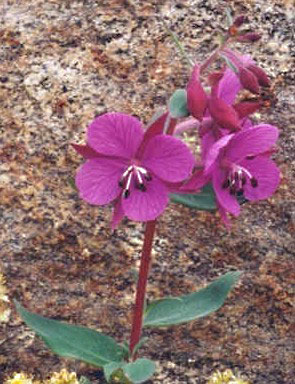Onagraceae
Onagraceae, commonly known as the evening primrose family, is a family of flowering plants that includes a number of important agricultural and horticultural plants. The family is characterized by its wide distribution across the globe, with species found in temperate, subtropical, and tropical regions. Members of the Onagraceae family are diverse in their growth forms, including herbs, shrubs, and trees, and they are particularly noted for their attractive flowers and ecological importance.
Description[edit | edit source]
Plants in the Onagraceae family typically have simple, often opposite leaves and usually produce flowers that have four petals. The flowers are frequently large and conspicuous, with some species, such as the evening primrose (Oenothera biennis) and fuchsia (Fuchsia spp.), being particularly noted for their beauty and intricate structures. The family is also characterized by its unique fruit types, often capsules or berries, which contain numerous small seeds.
Ecology[edit | edit source]
Onagraceae species play significant roles in their ecosystems. Many are important food sources for pollinators, including bees, butterflies, and moths, with some species having specialized relationships with their pollinators. Additionally, the seeds and foliage of some Onagraceae plants serve as food for various insects and wildlife, contributing to the biodiversity of their habitats.
Economic Importance[edit | edit source]
Several members of the Onagraceae family have economic significance. For example, the evening primrose oil, derived from the seeds of Oenothera biennis, is used in dietary supplements and cosmetics due to its high content of gamma-linolenic acid, a type of essential fatty acid. Fuchsia plants are widely cultivated as ornamentals for their striking flowers, suitable for gardens and containers.
Genera and Species[edit | edit source]
The Onagraceae family comprises approximately 650 species distributed among about 20 genera. Some of the notable genera include:
- Oenothera – Evening primroses
- Fuchsia – Fuchsias
- Epilobium – Willowherbs
- Ludwigia – Water primroses
- Clarkia – Clarkias
Each of these genera contains species with distinct characteristics and adaptations, showcasing the diversity within the family.
Conservation[edit | edit source]
While many Onagraceae species are common and widespread, some are threatened or endangered in their natural habitats. Habitat destruction, invasive species, and climate change are among the primary threats to these plants. Conservation efforts are essential to protect the more vulnerable species within the family, ensuring the preservation of their ecological roles and genetic diversity.
Conclusion[edit | edit source]
The Onagraceae family is a significant group of plants with ecological, aesthetic, and economic value. Its members are appreciated for their beauty, ecological roles, and various uses in horticulture and industry. Continued research and conservation efforts are vital to understand and protect the diversity within this fascinating family.
Search WikiMD
Ad.Tired of being Overweight? Try W8MD's physician weight loss program.
Semaglutide (Ozempic / Wegovy and Tirzepatide (Mounjaro / Zepbound) available.
Advertise on WikiMD
|
WikiMD's Wellness Encyclopedia |
| Let Food Be Thy Medicine Medicine Thy Food - Hippocrates |
Translate this page: - East Asian
中文,
日本,
한국어,
South Asian
हिन्दी,
தமிழ்,
తెలుగు,
Urdu,
ಕನ್ನಡ,
Southeast Asian
Indonesian,
Vietnamese,
Thai,
မြန်မာဘာသာ,
বাংলা
European
español,
Deutsch,
français,
Greek,
português do Brasil,
polski,
română,
русский,
Nederlands,
norsk,
svenska,
suomi,
Italian
Middle Eastern & African
عربى,
Turkish,
Persian,
Hebrew,
Afrikaans,
isiZulu,
Kiswahili,
Other
Bulgarian,
Hungarian,
Czech,
Swedish,
മലയാളം,
मराठी,
ਪੰਜਾਬੀ,
ગુજરાતી,
Portuguese,
Ukrainian
Medical Disclaimer: WikiMD is not a substitute for professional medical advice. The information on WikiMD is provided as an information resource only, may be incorrect, outdated or misleading, and is not to be used or relied on for any diagnostic or treatment purposes. Please consult your health care provider before making any healthcare decisions or for guidance about a specific medical condition. WikiMD expressly disclaims responsibility, and shall have no liability, for any damages, loss, injury, or liability whatsoever suffered as a result of your reliance on the information contained in this site. By visiting this site you agree to the foregoing terms and conditions, which may from time to time be changed or supplemented by WikiMD. If you do not agree to the foregoing terms and conditions, you should not enter or use this site. See full disclaimer.
Credits:Most images are courtesy of Wikimedia commons, and templates, categories Wikipedia, licensed under CC BY SA or similar.
Contributors: Prab R. Tumpati, MD

